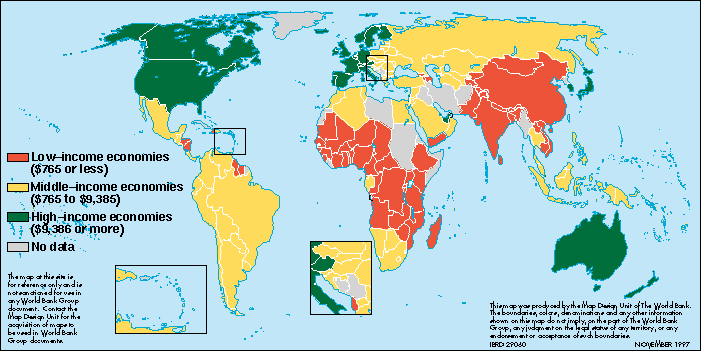
TEXTBOOK CHAPTER OUTLINE AND INSTRUCTOR'S ADDITIONS
Chapter 22 - Economic Growth and the Less Developed Countries:
Economics of Developing Countries
I use the term "Less Developed Countries" or "LDCs" for the world's poor countries and "More Developed Countries" or "MDCs" for the world's richer countries. The authors of our textbook use the term "developing countries" or "DVCs" for the poor countries and "Industrially Advanced Countries" or "IACs" for the richer countries.
GDP per capita

For the GNP of individual countries see: [gnppctab.htm]
GNP is the total market value of all final goods and services produced by a country in one year. It is a measure of economic activity, or how much is produced in a country. The more that a country produces per person , the more "developed" it is assumed to be.
Which country produces more (has a higher GNP), India or Switzerland? Which is more "developed"?
The GNP of India is $336 billion and the GNP of Switzerland is $288 billion. India produces more than does Switzerland, but everybody would agree that Switzerland is more economically advanced. Why?
The answer is population. the population of India is 988 million and the population of Switzerland is 7 million. Therefore we must compare GNP PER CAPITA. To calculate GNP per capita (or income per person) we divide the GNP by the population. The GNP per capita of Switzerland is $40,630 and the GNP per capita of India is $ 340.
Remember, always use GNP PER CAPITA when comparing the economic conditions of different countries.
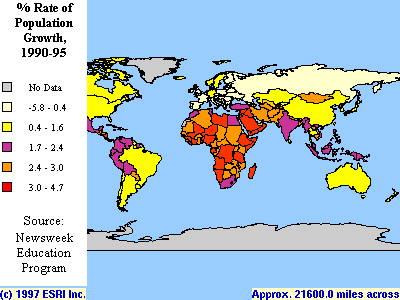
In general, poorer countries have more rapid rates of population growth. Compare the GNP per capita map with the population growth rate map to verify that this general trend is true. You may have to go back a forth between them several times checking a different region of the world each time.
After comparing the maps look here for a graph showing population growth rates by area.[popgrrlm]
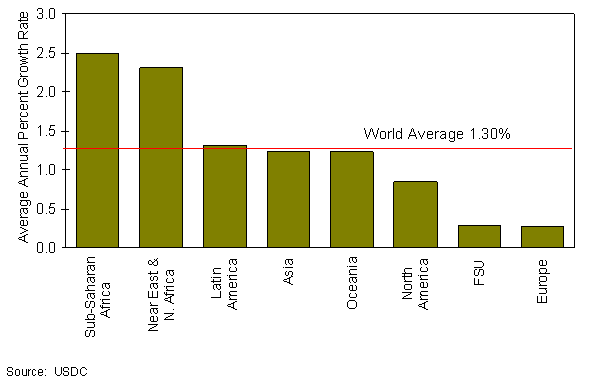
Even though population growth rates seem small (1%, 2% 3%, or maybe 4%) they have a big impact. a useful way to see this is by using the "Rule of 70".
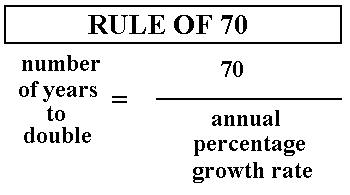
The rule of 70 is a way to ESTIMATE the number of years it takes for something to DOUBLE if you know the annual percentage growth rate. Therefore, the population of the United States with an annual population growth rate of 1% will double in about 70 years IF THE POPULATION GROWTH RATE REMAINS AT 1%. The population of the country of Mozambique, Southern Africa, with an annual population growth rate of 4% will double in 17.5 years, quadruple in 35 years and increase by a factor of 8 in 70 years IF THE POPULATION GROWTH RATE REMAINS AT 4%. So a small change in the population growth rate results in significant increase in population. You should now examine table I-1 of your textbook and see how well the rule of 70 calculates the population doubling time. (Note: the textbook uses the rate of "Natural Increase" to measure the population growth rate.)
OPTIONAL:
For more information see: http://geography.about.com/education/geography/library/weekly/aa051800a.htm
Occupational Structure of the Labor Force [wraglab]
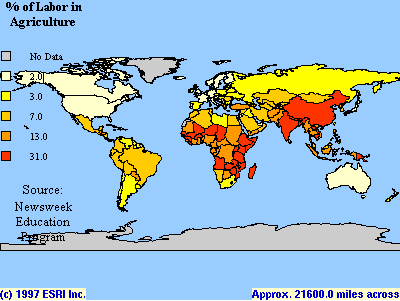
Economic geographers divide economic activities into primary activities, secondary activities, and tertiary activities. (Some add quaternary activities and quinary activities, but we will not.)
PRIMARY ACTIVITIES are those that directly remove resources from the earth. Generally they include AGRICULTURE, MINING, fishing, and lumbering.
SECONDARY ACTIVITIES involve converting resources into finished products. These are the MANUFACTURING activities.
TERTIARY ACTIVITIES comprise the SERVICE sector of the economy. The tertiary activities include retailing, transportation, education, banking, etc.
As countries develop the occupational structure of the labor force changes. In LDCs most people are engaged in primary activities. In high income countries like the United states most people are involved with the tertiary sector.
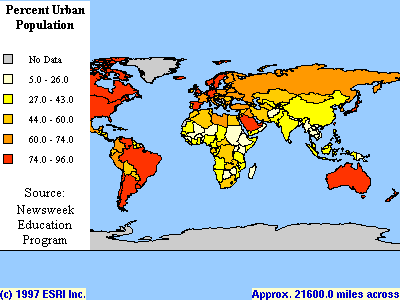
Urbanization is the percentage of a country's population who live in urban areas. Urban areas generally means in towns and cities of 2,500 or more people. Currently just less than half of the worlds population live in urban areas. Generally as countries develop urbanization increases.
Note the high urbanization found in the more developed countries and in South America.
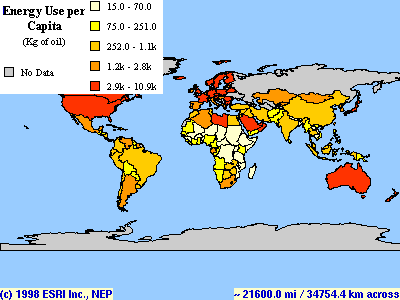
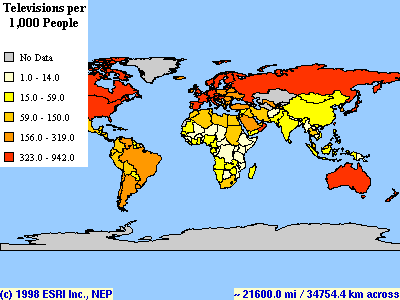
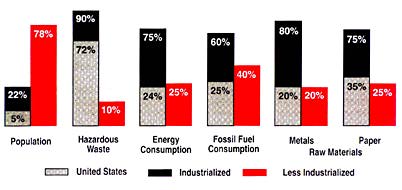
Consumption per person is a good indicator of development. The richer a country is, the more its citizens consume. This map shows the energy consumption patterns for the world. Similar maps could be made for "televisions per capita" or "cars per capita".
One consequence of consumption is pollution:
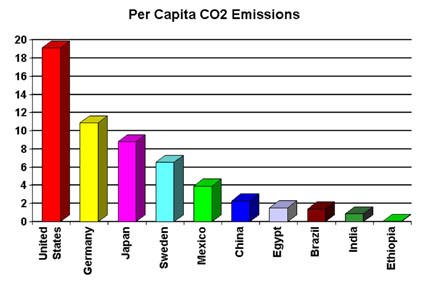
Carbon dioxide (CO2) is emitted when fossil fuels are used. Scientists are studying the connection between CO2 build up in the atmosphere ant global warming. this chart shows CO2 emissions for various countries
Infrastructure [wwtrans]
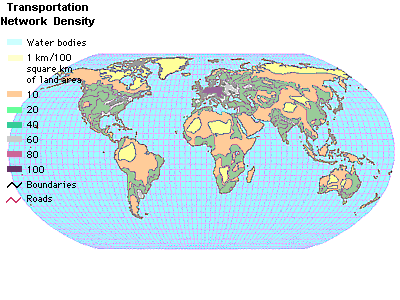
A country's infrastructure is defined by our author as "the foundations of a society: urban centers, transport networks, communications, energy distribution systems, farms, factories, mines, and such facilities as schools, hospitals, postal services, and police and armed forces."
This map shows the state of development of the transportation system as a measure of its length per area of land. The darker the color the more developed is the transportation system and hence, a greater the degree of economic development is assumed.
Social Conditions
There are many other measures of economic development. Many refer to the social conditions of a country. Here is a short list.
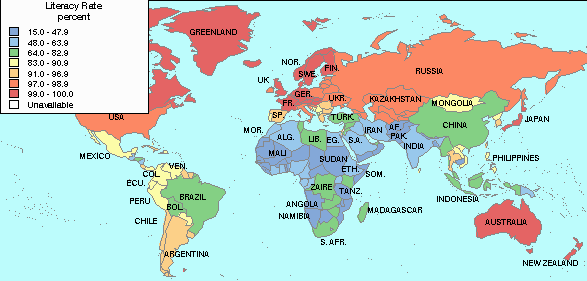

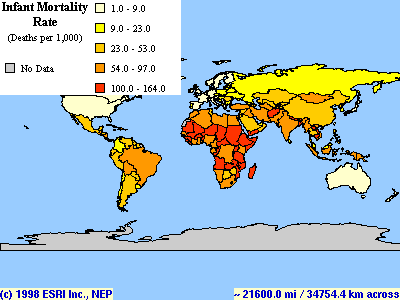
TEXTBOOK OUTLINE
[Pay closer attention to the highlighted areas]
I. The Rich and the Poor (pp. 417-420)
A. Industrially advanced countries (IACs) include the U.S., Canada, Australia, New Zealand, Japan, and most of western Europe. They have developed market economies based on large stocks of capital goods, advanced technologies, and a well-educated labor force. They have a high per capita output, as seen in Figure 22-1.
2. The low-income group is the poorest with average output per capita of only $410 and a range to $755. Dominating this group are India, China, and the sub-Saharan African nations.
C. Comparisons highlight income disparities.
I find this information amazing !!
2. The U.S. has 5 percent of the population but
produces 27 percent of the world’s output. 3. The largest U.S. corporations have sales greater
than most DVC nations’ output. General Motors had
sales greater than the output value of all but 22
lower-income nations of the world. 4. The assets of the three wealthiest people in the
world exceeded the combined GDPs of the 48 poorest
nations.
1. U.S. 1999 GDP was more than the total
output of the poorest 109 countries combined.
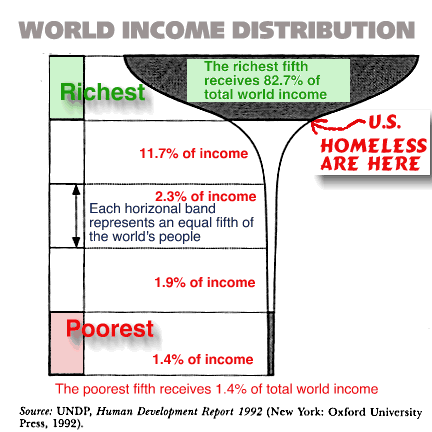
D. Growth, Decline, and Income Gaps1. DVCs such as China, Malaysia and Thailand have achieved high annual growth rates in their GDPs in recent decades. Several previous DVCs, such as South Korea, Singapore, and Hong Kong have achieved IAC status. But many DVCs, such as those in sub-Saharan Africa, have experienced declining GDPs per capita. 2. The absolute income gap between rich and poor nations has been widening. For example, if per capital income is $400 a year in a DVC, a 2% growth rate means an $8 increase in income. Where per capita income is $20,000 per year in an IAC, the same 2% growth rate translates into a $400 increase in income.
II. Obstacles to Economic Development (pp. 420-427)
A. Natural resources must be used more efficiently and their supplies expanded. Resource distribution is very uneven as is evidenced by the wealth of the OPEC countries. Often ownership of natural resources is an issue if they belong to corporations in industrially advanced countries. However, weak resource bases are not necessarily impossible to overcome, as Switzerland, Israel, and Japan have shown.B. Human resources in DVCs have three characteristics
1. Overpopulation is the rule. An annual population growth of approximately 1.8 percent in these countries means that their populations double approximately every 35 years. This compares to an average 0.7 percent rate of population growth in advanced countries. It means that economic growth must be very rapid to make any gain on population; DVC per capita incomes are lagging behind the IACs (see Table 22-2)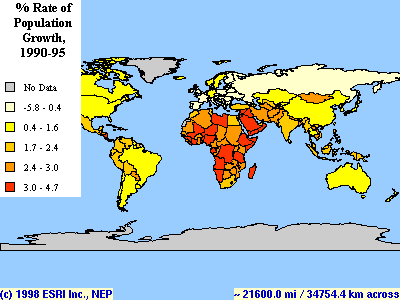
a. Population growth accelerates with economic growth as better living conditions extend life.
b. Birth rates remain high as medical care and sanitation cut infant mortality.
2. Population growth hinders development because large families create obstacles to development. They reduce the ability of households to save, more investment is required to keep up with increases in the labor force, an overuse of agricultural land may occur, and massive urban problems are generated.
3. Other reasons exist in explaining why expansion hinders development.
a. Possible solutions include China’s "one-child" program, but many nations have religious and sociocultural reasons to oppose contraception or birth control.b. Three additional points are worth noting.
i. The relationship between population and economic growth is not as clear as it seems. Japan and Hong Kong are densely populated, but wealthy. Did the wealth come before or after population growth rates declined?ii. Population growth rates for the DVCs in general have declined in recent decades.
iii. The traditional view is that reduction in population growth leads to economic development. But the "demographic transition" theory maintains that rising incomes lead to slower population growth. Children are viewed more as economic liabilities as the wealth of a country becomes greater. (Key Question 6)
4. High unemployment and underemployment are characteristics of DVCs with rates in the vicinity of 15 to 20 percent. This may become worse as rural populations migrate to cities in the hope of finding jobs that are not there. Underemployment occurs when workers are employed less time than desired or at jobs that do not fully utilize their skills.
5. Low labor productivity occurs because there has not been enough investment in physical or human capital. Furthermore, often there is no entrepreneurial class. Higher education is often oriented toward the humanities rather than technical areas, and some of the best workers have migrated from their home countries, causing what is called the "brain drain."
C. Capital accumulation is an important focus.
1. All DVCs suffer from a lack of capital goods—factories, machinery and equipment, public utilities, etc. Better equipped workers would improve productivity.2. Increasing the stock of capital goods is crucial because of the very limited possibility of increasing the supply of arable land.
3. Once begun, the accumulation of capital may be cumulative if it can raise output faster than the population grows.
4. Domestic capital formation must come as a result of domestic saving. A nation cannot consume everything it produces if it wants to invest in the future.
5. Savings potential is not promising in the poorest countries and may require foreign investment in these countries.
6. Another concern has been capital flight, which occurs when citizens who have been able to save transfer their savings to the IACs for safety and higher returns. This is a quantitatively significant problem.
7. Obstacles to investment include the lack of investors but also the lack of incentive to invest. Education and skilled workers as well as an adequate infrastructure are needed to encourage private investment.
8. One potential bright spot is in-kind or nonfinancial investment in the form of surplus labor working on the improvement of the infrastructure and other capital improvements.
D. Technological advance is a somewhat separate process from capital formation. In some cases DVCs are able to transfer new technologies that are capital-saving. Technological borrowing has aided the rapid growth of Pacific Rim region; OPEC nations have benefited in similar ways and the former Soviet bloc countries and republics are seeking western technology. On the other hand, DVCs often require technology appropriate to their resource mixes and must develop their own.
E. Sociocultural and institutional factors: One intangible ingredient is the "will to develop."
1. Sociocultural obstacles to growth exist.a. Tribal allegiances may take precedence over national identity.b. Religious beliefs and observances may restrict the length of the productive workday.
c. A caste system may allocate labor inefficiently.
2. Institutional obstacles also exist, especially the problem of land reform in these predominantly agricultural countries.
III. The Vicious Circle of Poverty (p. 427)
A. Poverty makes it difficult to grow. The obstacles to development listed in this chapter seem to arise from poverty. How can a country break the cycle of poverty?B. Increasing the rate of capital accumulation may help, but only if the rate of population growth is somehow slowed at the same time. (Key Question 13)
IV. The Role of Government (pp. 427-429)
A. A positive role exists for government, according to one perspective.1. Government provides law and order.2. The absence of entrepreneurship means that government may have to substitute in spearheading investment.
3. The infrastructure like education, highways, and other government services, depend on adequate public investment in these projects.
4. Forced saving and investment may also require government intervention.
a. Increasing taxes is one alternative.b. Government can cause inflation by creating and spending new money on public projects and by selling bonds to banks and spending the proceeds. The resulting inflation is like an arbitrary tax on the economy, but there are objections to creating investment in this way.
5. Social-institutional problems like land ownership and population growth can be alleviated by government policy.
B. Public sector problems exist in the DVCs.
1. Entrepreneurial ability is lacking in the public sector, too.2. Many DVCs have histories of government corruption and poor administration and much of these economies is state-owned or state-controlled.
V. Role of the Advanced Nations (pp. 429-432)
A. Expanding trade may be the simplest way to benefit DVCs, and IACs can lower trade barriers against DVC products. However, many countries need basic capital and assistance to produce export.B. Foreign aid
What fraction of the U. S. federal government's budget is spent on FOREIGN AID?
ANSWER
1%
5%
10%
15%
20%
25%
HOW MUCH AID DO WE GIVE?
The US compared to other MDCs:
Foreign Aid can take several forms.
1. Public loans and grants from governments: In the last decade, U.S. aid has averaged about $10 to 14 billion per year, mostly administered by the Agency for International Development (AID). Total IAC has been $40-60 billion per year. (Global Perspective 22.2)2. The World Bank Group, supported by about 180 member nations including the U.S., lends out capital funds to DVC governments and also sells bonds and guarantees and insures private loans.
a. The World Bank is a "last resort" lending agency whose loans are limited to productive projects for which private funds are not available.b. Many World Bank loans are for basic development projects, such as infrastructure that is needed to attract private capital.
c. The World Bank also provides technical assistance.
d. Two World Bank affiliates supplement the Bank’s activities: The International Finance Corp. invests in private corporations in the DVCs; The International Development Association (IDA) makes "soft loans" to the poorest DVCs on more liberal terms than the World Bank.
C. Criticism of foreign aid to DVCs takes several forms.
1. A basic charge is that foreign aid, like welfare programs, creates dependency.2. The recipients of much foreign aid end up being the bureaucracy and centralized governments of the receiving country.
3. Corruption and misuse characterize too much foreign aid. Many of the beneficiaries are IAC-based consultants and multinational corporations.
4. Foreign aid declined from $58 billion in 1990 to $40 billion in 1999.
D. Private capital flows mostly from large corporations, and private banks also enter DVCs, rising from about $50 billion in 1990 to $250 billion in 1999.
VI. Where from here? (pp. 432-434)
A. DVC policies for promoting growth. (Note the many Structural Adjustment Program Policies.)1. Establishing and strengthening the rule of law. Clearly defined and enforced property rights bolster economic growth by ensuring that individuals receive and retain the fruits of their labor.2. Opening economies to international trade.
3. Controlling population growth.
4. Encouraging foreign direct investment.
5. Building human capital, programs which increase basic literacy, education, and labor-market skills help enhance economic growth.
6. Making peace with neighboring countries.
7. Establishing independent central banks.
8. Establishing realistic exchange rate policies.
9. Privatizing many state run industries.
B. IAC policies for fostering DVC growth.
1. Directing foreign aid to the poorest DVCs, much of foreign aid from IACs is strongly influenced by potential and military considerations. Only one-fourth of foreign aid goes to those 10 countries whose population constitutes 70 percent of the world’s poorest people.2. Reducing tariffs and import quotas.
3. Providing debt relief to DVCs.
4. Admitting temporary workers while discouraging brain drains.
5. Discouraging arms sales to the DVCs.
VIII. LAST WORD: Famine in Africa
A. Famine is not uncommon and caused about 300,000 deaths of children in Somalia in early 1990s; in 2000 an estimated 12 million people in 10 African countries are threatened by famine.B. Immediate cause of famine is drought, but other causes are a more complex interaction of civil strife, overpopulation, soil erosion, and counterproductive public policies.
1. Civil strife has torn many countries for decades. Somalia is one example.2. Population growth has outstripped food production; population growth in Africa averages 2.2% per year but only .6% per year in IACs.
3. Ecological degradation has occurred in countries struggling to employ marginal land for crop production.
4. Ill-advised public policies and large international debt are other causes:
a. Some governments spend four times as much on arms as they do on agriculture.b. Many African governments have followed the policy of establishing prices of agricultural goods at low levels to provide cheap food, but it diminishes incentives to produce.
c. External debt of about $230 billion in 1999 force sub-Saharan countries to cut back on needed domestic programs.
Foreign Aid Quiz Answer:
What fraction of the U. S. federal government's budget is spent on
FOREIGN AID?
ABOUT 1 % OF THE US FEDERAL BUDGET IS SPENT ON FOREIGN AID.
[Back]